Home
A comprehensive resource for safe and responsible laser use

Laser toy updates
2021
A paper published online in March 2021, entitled "Laser toys fail to comply with safety standards - case study based on laser product classification," has a number of problems including:
- An erroneous title; it should be "Laser toy fails to comply…" The case study is not about "toys" plural. It covers only one sample of one toy rifle which had a laser aiming device that was found to be misclassified.
- Stating that the toy laser's output power (1.7 mW) is illegal, when it may have been legal or close to legal (within 0.7 mW) at time of sale.
- Calling the laser's light output "radiation" 14 times and never using the more precise term "light," thus giving a misleading impression the hazard might be similar to that of X-radiation or nuclear radiation.
- Stating without any proof or reference that children "will usually try to look directly into the laser beam."
- Stating without any proof or reference that children "could have temporary disturbances of vision… lead[ing] to a tragedy."
- Stating without any proof or reference that there is such a thing as "hypersensitivity to laser radiation."
- Stating without any proof or reference that "the described laser toy… [is] easily available and [is] still sold as toys in many European states."
- Listing in the References studies claiming laser "toy" injuries, which actually were from standard, non-toy laser pointers.
In our analysis we concluded that a toy gun with no laser is about 900 times more hazardous than a standard laser pointer, based on U.S. emergency room records.
A summary of the paper, with LaserPointerSafety.com's commentary expanding on the above problems, is here.
2015
In late 2015, two stories appeared that claimed eye injuries were caused by laser toys. Upon closer examination, however, in both cases the lasers in question were likely laser pointers or pointer-like handheld lasers (e.g. a general-purpose laser in the form of a cylinder that emits a laser beam when a button is pressed).
“Child’s toy laser gives bus driver permanent vision loss”
A British Medical Journal Case Report published online on October 5 2015 stated “Here we present the first case of retinal injury caused by the laser beam of a toy laser pointer operated by a school boy and directed via the rear-view mirror of a bus into the eye of the driver.” However, the authors of the case report did not know the type of laser, or whether it was a toy, since the laser was never recovered or identified.
The injuries were consistent with a low-powered laser, in the 5 mW range. So it is entirely possible that it was a standard (not “toy”) laser pointer. In fact, the authors used descriptions and a photo of a laser pointer as if it was the laser in question. But they provided no indication or reason for claiming that the laser was a toy, or had been marketed as a toy or to children.
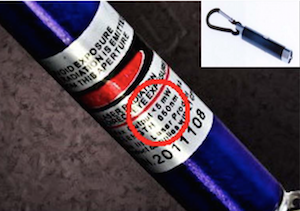
The authors’ description of this photo: “Typical handheld toy laser pointer with an output power of 5 mW.”
Popularizations of the story appeared in early November at some scientific and general interest news sites such as LiveScience.com and the Palm Beach Post. (The quoted headline above is from the Post.) Secondary sources such as these unquestioningly picked up on the “toy” claim, identifying the laser as a toy in their headlines and stories. A link to the original BMJ Case Report, plus a summary and detailed analysis, are here.
“Eye Damage from Powerful Laser Toys Alarms Ophthalmologists”
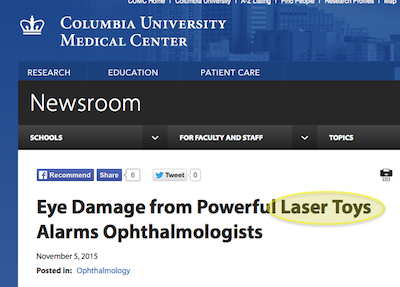
This November 5 2015 blog post was from Columbia University Medical Center. It references a paper published in the online edition of Ophthalmic Genetics, “Laser induced photic injury phenocopies macular dystrophy.”
While the CUMC headline says “laser toys” caused eye damage, and the second sentence states that “Inexpensive and extremely powerful lasers are now marketed as toys…” both of these statements appear to be untrue.
LaserPointerSafety.com corresponded with the Columbia University doctor who examined the lasers. He indicated that the lasers were over 5 mW in power and were similar to Wicked Lasers’ products. In other words, they were general-purpose handheld lasers that have the form factor of a laser pointer or flashlight.
Interestingly, a search of Wicked Lasers’ website that day showed that the company does not sell toys or to children. For example, the online product information for the 2000 mW Spyder III Arctic makes clear that these are not toys:

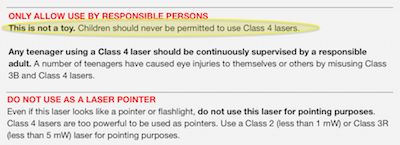
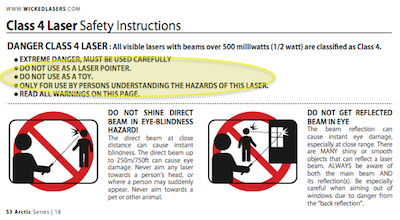
Top to bottom: Wicked Lasers’ Arctic website, a linked page with safety information, and the online & printed user manual
In summary, the Columbia University doctor never presented any evidence that the injury-causing lasers were toys, or were marketed as toys, could be purchased by children without adult help, or that children were playing games with the laser devices.
In a November 6 email to the CUMC communications director, LaserPointerSafety.com editor Patrick Murphy gave further reasons that the “toy” designation should never have been used:
The children in the CUMC-reported study may have been misusing lasers, but this "playing" does not turn the lasers into toys. For example, consider children who injure themselves with household knives. No one would write a headline such as "Skin Injuries from Sharp Kitchen Toys Alarms Pediatricians" or "Knife Toys Cause Concern."
Similarly, it would be flat-out wrong to write stories about the thousands of children injured or killed by misusing firearms using headlines such as "Toy Gun Kills Toddler" or "7,300 Children Admitted to U.S. Hospitals Every Year Due to Gun Toys."
I assume CUMC wants to accurately describe the facts of a story. For this reason alone, the headline and text should be corrected.
In addition. I am concerned not only that the CUMC's story "toy" designation is incorrect, but also that the story will cause confusion among the public. Cautious parents will be on the lookout for powerful laser "toys" that do not exist -- and they may not realize the genuine hazard of over-powered pointer- and flashlight-type devices. The CUMC story also unfairly stigmatizes genuine toys that contain safe, FDA-reviewed lasers.
I therefore request that the headline and any sentences about "toys" be rewritten. Parents should be made aware that children should not be allowed access to laser pointers, or pointer-like powerful handheld lasers. A number of teenagers have harmed themselves or others, so even older (teenage) children should be closely supervised by an adult.
UPDATE June 21 2016
Checking the CUMC website story, the headline has been changed, to “Eye Damage from Powerful Lasers Alarms Ophthalmologists”:
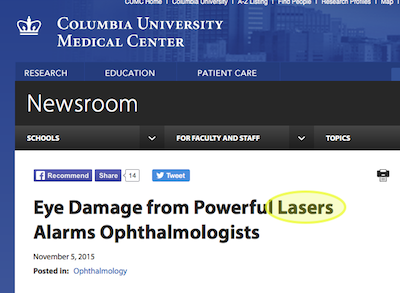
In addition, the second sentence, which previously referenced toys, now reads “Inexpensive and extremely powerful lasers are now available for purchase on the Internet.”
These are welcome changes which make the story accurate, and clarify that any powerful laser can cause eye damage.